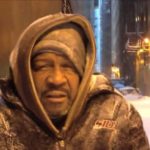By David A. Love | ecoWURD Contributor
While the federal government was partially shutdown from an impasse over a $5.7 billion demand for a border wall on the U.S.-Mexico border, Newark, New Jersey Mayor Ras Baraka wrote a letter to President Trump.
“I am writing to express my deep concern that you are seriously thinking of declaring a national emergency to fund a proposed $5 billion border wall,” Baraka wrote in mid-January. “I want to bring your attention to a true emergency that puts millions of our citizens at risk: The decaying infrastructure of our water systems which has created a crisis in Newark, the State of New Jersey and across America.”
Baraka made a point: there really was no crisis on the border, so why use resources for a crisis that didn’t exist as opposed to dedicating money for a crisis that actually did? But, the former high school principal also had reason to openly worry. He was facing a lawsuit since summer 2018 from the Natural Resources Defense Council which argued that his city’s lead-in-water poisoning was a lot bigger than what the city wanted to admit. For NRDC, it was so bad that the environmental advocacy organization designed a special page on its website about it. The water was never safe: Newark was faced with the state’s largest lead poisoning problem, according to the New Jersey health department. And it was a crisis where 13 percent of New Jersey’s children with elevated blood lead levels lived in Newark – yet, they constitute only 3.8 percent of the entire state’s under-18 population.
Pressed to get in front of it, Baraka didn’t want Newark becoming another public Flint – even though the NRDC said it already was. Yet, the mayor went national in a desperate move to spark conversation about who was suffering more and how much a concerted response would cost. “This crisis, mainly, affects older black and brown cities with limited resources and serious health issues that are systemically overlooked by every level of government,” argued Baraka. “It will cost an estimated $70 million to replace the lead service lines in Newark, hundreds of millions more to replace them in New Jersey, and an estimated $35 billion to replace all of the lead service lines in America.”
Baraka, however, could be on to something. America’s aging water infrastructure isn’t just old, it’s crumbling and dangerous. The American Society of Civil Engineers even gives national drinking water quality an overall grade of “D” in its annual Infrastructure report card. And with water systems under growing strains from population overuse, governments on the local, state and federal level have not prioritized how they’ll fix it. What’s worse is that underserved communities using toxic water supply are unwittingly exposed to poisons and an imperiled situation in which there is little recourse and few answers.
REMEMBERING FLINT
These days, when the topic of environmental racism comes up, Flint, Michigan is the first thing most people think about. The rusty, economically depressed and majority-Black old manufacturing town of 96,000 residents has become synonymous with environmental injustice in the way that Chernobyl, Russia is forever implanted on the global map as ground zero for nuclear meltdowns. That’s made the Flint water crisis a flashpoint in the fight against environmental racism, triggering outrage and shedding light on the pervasive problem of water toxicity in America’s cities.
But Flint was never a fluke. Not is it an outlier or a special case scenario. Water quality is a deadly serious issue. And it is national – indeed, it is so widespread and disproportionately impactful on Black people and low income communities that we have yet to fully comprehend the enormity of it.
It always helps to recap on Flint, however, since the story is notoriously indicative of how much urban water quality is tied to governmental and institutional neglect. Problems surfaced when the state-appointed emergency financial manager in Flint decided to replace the city’s water source with the already toxic Flint River in an attempt to save money. Flint had drawn its water from Detroit, which sourced its water from the Detroit River and Lake Huron.
But, the state government’s bid to cut corners resulted in the lead poisoning of thousands of Flint residents who regularly accessed the tainted water through old and corroded pipes.Sadly, over 80 people were infected with Legionnaire’s Disease, from which at least a dozen died (that we know of). Studies also suggest there’s an entire generation of Flint children, mostly Black, who will suffer from lead-triggered chronic and neurological disease for years. Officials denied there was a crisis, yet 15 current and former officials were officially charged. When Flint Mayor Karen Weaver (D) concluded that race and class were clear factors in the decision to switch the water supply, dictating the slow response by state authorities, then-Michigan Gov. Rick Snyder (R) reportedly told her to “get over it.”
The most prominent feature of this scandal: Flint’s population is 53.9 percent Black, and 41.2 percent of the city lives in poverty. Per capita income is $15,622, the median household income is $26,330, and the median home value is $28,200.
WATER QUALITY IS JUST AS BIG, JUST AS BAD
The unfortunate consequence of so much focus on climate change is the false public impression that the phenomenon explains everything wrong with the environment today.
But it’s not just climate change. That’s just one out of many variables creating ecological and public health calamities. Issues such as water quality, which was an issue long before climate change was even scientifically recognized, are an entirely separate space of environmental study. And through every season of climatic weather, whether hot or cold, the topic of water will always come up because every human being needs it. That’s a problem because there’s increasing evidence it’s getting dirtier with each passing year.
Just like Flint, there are a lot of other cities with the same demographic features. The implications for Flint, a Black city poisoned and its health compromised, reverberate across the nation. As serious as the Flint water crisis has become, Flint does not stand alone, and it’s not even the worst example.
Reuters, for example, found that 3,810 neighborhoods had lead levels at least double the amount found in Flint’s water. This was after a thorough examination of testing data from 34 states and the District of Columbia. In 1,300 of these communities, lead levels were at least four times higher.
Philadelphia is among the most glaring instances of massive citywide lead poisoning. In 2014, Philadelphia –a city where 39 percent of the children live in poverty– tested nearly 36,000 children under the age of 7 and found that 10.2 percent had blood levels of 5 micrograms or higher, higher than the 3.3 percent of children who were tested in Flint. A Guardian investigation later discovered that Philly was one of 33 cities using water testing “cheats” to hide high contamination levels, reflecting poor testing found in places such as Flint. That lead problem in Philadelphia is compounded by lead-based paint in houses constructed before the 1978 federal ban.
Across the country, Black people are particularly susceptible to lead poisoning. This is especially the case in federally assisted housing where 48 percent of the residential population is Black – living on properties where HUD even admits 62,000 units require lead abatement. Meanwhile, Philly is just one of 18 cities in Pennsylvania – 11 in New Jersey – with a higher percentage of children suffering from elevated lead levels than Flint.
IS WATER BEING “WEAPONIZED?”
In 2016, 5,300 water systems serving nearly 18 million Americans were in violation of the EPA’s lead and copper rule, a 1991 regulation designed to protect public health through the monitoring of drinking water. As many as 63 million people were exposed to unsafe drinking water, particularly those living in poor, small and Black and Brown communities due to aging infrastructure and lack of funding to purchase equipment to filter out water contaminants, according to a News21 investigation.
A report from the nonprofit corrosion association NACE International found that the nation’s aging water infrastructure is an urgent problem and a threat to public health. Corroding water lines expose millions of Americans to dangerous levels of lead and other toxins. The price tag for replacing this decrepit U.S. water infrastructure, by NACE’s estimates: $80 billion per year (that dwarfs the figure in Baraka’s letter to Trump).
According to the Environmental Protection Agency (EPA), young children, infants, and fetuses are particularly susceptible to lead poisoning because “the physical and behavioral effects of lead occur at lower exposure levels in children than in adults.” It’s worse, says the EPA, for children. “Low levels of exposure have been linked to damage to the central and peripheral nervous system, learning disabilities, shorter stature, impaired hearing, and impaired formation and function of blood cells.” The Centers for Disease Control and Prevention (CDC) recommends that public health action be taken when a child’s blood has 5 micrograms of lead per deciliter (µg/dL) or more.
Still, African Americans are more than twice as likely as Whites to live in homes with inferior plumbing, due to a legacy of discriminatory land use practices. Latinos and Native Americans suffer from disparities in access to safe drinking water, too.
Water has always played a crucial and tragic role in African American history, as Tyler Parry of California State University, Fullerton has aptly noted. “One finds that water holds a dual role in the history of Black culture and intellectual thought,” notes Parry. “In one sense, water is an arena for resistance that liberates, nourishes, and sanctifies a people, but it can also be weaponized by hegemonic forces seeking to degrade, poison, or eliminate rebellious populations.
Adds Parry: “Positioning water as a tool of violence in Black Atlantic history requires one to revisit the slave ship.”
There is a needed exercise to understand that, fundamentally, water, as nourishing as it’s viewed, has been historically weaponized against Black people. It oppressed ancestors by means of the slave ship dungeons that carried Africans across the Middle Passage and left millions of souls at the bottom of the Atlantic. Conversely, it also plays a central role in Black cultural rituals, as well as Black liberation from enslavement. Still, today’s crisis reveals a new and much more uncertain front Black people must face in a larger war for basic survival – and a simple glass of water.



